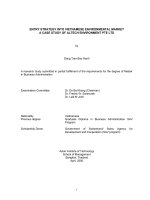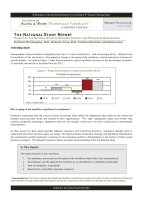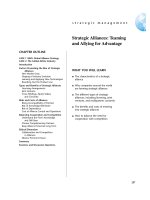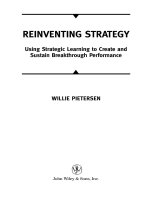Entry strategy and strategic alliances
Bạn đang xem bản rút gọn của tài liệu. Xem và tải ngay bản đầy đủ của tài liệu tại đây (269.08 KB, 47 trang )
International
Business 7e
by Charles W.L. Hill
McGraw-Hill/Irwin Copyright © 2009 by The McGraw-Hill Companies,
Inc. All rights reserved.
Chapter 14
Entry Strategy and
Strategic Alliances
14-3
Introduction
Firms expanding internationally must decide:
which markets to enter
when to enter them and on what scale
which entry mode to use
Entry modes include:
exporting
licensing or franchising to a company in the host nation
establishing a joint venture with a local company
establishing a new wholly owned subsidiary
acquiring an established enterprise
14-4
Introduction
Several factors affect the choice of entry mode including:
transport costs
trade barriers
political risks
economic risks
costs
firm strategy
The optimal mode varies by situation – what makes sense for one
company might not make sense for another
14-5
Basic Entry Decisions
Firms entering foreign markets make three basic decisions:
1. which markets to enter
2. when to enter those markets
3. on what scale to enter those markets
14-6
Which Foreign Markets?
The choice of foreign markets will depend on their long run profit
potential
Favorable markets are politically stable developed and developing
nations with free market systems and relatively low inflation rates and
private sector debt
Less desirable markets are politically unstable developing nations
with mixed or command economies, or developing nations with
excessive levels of borrowing
Markets are also more attractive when the product in question is not
widely available and satisfies an unmet need
14-7
Timing Of Entry
Once attractive markets are identified, the firm must consider the
timing of entry
Entry is early when the firm enters a foreign market before other
foreign firms
Entry is late when the firm enters the market after firms have already
established themselves in the market
14-8
Timing Of Entry
First mover advantages are the advantages associated with entering
a market early
First mover advantages include:
the ability to pre-empt rivals and capture demand by establishing a
strong brand name
the ability to build up sales volume in that country and ride down the
experience curve ahead of rivals and gain a cost advantage over later
entrants
the ability to create switching costs that tie customers into products
or services making it difficult for later entrants to win business
14-9
Timing Of Entry
First mover disadvantages are disadvantages associated with
entering a foreign market before other international businesses
First mover disadvantages include:
pioneering costs - arise when the foreign business system is so
different from that in a firm’s home market that the firm must devote
considerable time, effort and expense to learning the rules of the game
Pioneering costs include:
the costs of business failure if the firm, due to its ignorance of the
foreign environment, makes some major mistakes
the costs of promoting and establishing a product offering, including
the cost of educating customers
14-10
Classroom Performance System
_______ refers to the time and effort spent learning the rules of a new
market.
a) First mover advantages
b) Strategic commitments
c) Pioneering costs
d) Market entry costs
14-11
Scale Of Entry And Strategic Commitments
After choosing which market to enter and the timing of entry, firms
need to decide on the scale of market entry
Entering a foreign market on a significant scale is a major strategic
commitment that changes the competitive playing field
Firms that enter a market on a significant scale make a strategic
commitment to the market (the decision has a long term impact and is
difficult to reverse)
Small-scale entry has the advantage of allowing a firm to learn about
a foreign market while simultaneously limiting the firm’s exposure to
that market
14-12
Summary
There are no “right” decisions when deciding which markets to enter,
and the timing and scale of entry, just decisions that are associated
with different levels of risk and reward
14-13
Entry Modes
These are six different ways to enter a foreign market:
1. exporting
2. turnkey projects
3. licensing
4. franchising
5. establishing joint ventures with a host country firm
6. setting up a new wholly owned subsidiary in the host country
Managers need to consider the advantages and disadvantages of
each entry mode
14-14
Exporting
Exporting is a common first step in the international expansion
process for many manufacturing firms
Later, many firms switch to another mode to serve the foreign market
14-15
Exporting
Exporting is attractive because:
it avoids the costs of establishing local manufacturing operations
it helps the firm achieve experience curve and location economies
Exporting is unattractive because:
there may be lower-cost manufacturing locations
high transport costs and tariffs can make it uneconomical
agents in a foreign country may not act in exporter’s best interest
14-16
Turnkey Projects
In a turnkey project, the contractor agrees to handle every detail of
the project for a foreign client, including the training of operating
personnel
At completion of the contract, the foreign client is handed the "key" to
a plant that is ready for full operation
Turnkey projects are common in the chemical, pharmaceutical,
petroleum refining, and metal refining industries
14-17
Turnkey Projects
Turnkey projects are attractive because:
they are a way of earning economic returns from the know-how
required to assemble and run a technologically complex process
they can be less risky than conventional FDI
Turnkey projects are unattractive because:
the firm that enters into a turnkey deal will have no long-term interest
in the foreign country
the firm that enters into a turnkey project may create a competitor
if the firm's process technology is a source of competitive advantage,
then selling this technology through a turnkey project is also selling
competitive advantage to potential and/or actual competitors
14-18
Licensing
A licensing agreement is an arrangement whereby a licensor grants
the rights to intangible property to another entity (the licensee) for a
specified time period, and in return, the licensor receives a royalty fee
from the licensee
Intangible property includes patents, inventions, formulas, processes,
designs, copyrights, and trademarks
14-19
Licensing
Licensing is attractive because:
the firm does not have to bear the development costs and risks
associated with opening a foreign market
the firm avoids barriers to investment
firms with intangible property that might have business applications
can capitalize on market opportunities without developing those
applications itself
14-20
Licensing
Licensing is unattractive because:
the firm doesn’t have the tight control over manufacturing, marketing,
and strategy required for realizing experience curve and location
economies
it limits a firm’s ability to coordinate strategic moves across countries
by using profits earned in one country to support competitive attacks in
another
proprietary (or intangible) assets could be lost
One way of reducing this risk is through the use of cross-licensing
agreements where a firm might license intangible property to a foreign
partner, but requests that the foreign partner license some of its
valuable know-how to the firm in addition to a royalty payment
14-21
Franchising
Franchising is basically a specialized form of licensing in which the
franchisor not only sells intangible property to the franchisee, but also
insists that the franchisee agree to abide by strict rules as to how it
does business
Franchising is used primarily by service firms
14-22
Franchising
Franchising is attractive because:
Firms avoid many costs and risks of opening up a foreign market
Firms can quickly build a global presence
Franchising is unattractive because:
It may inhibit the firm's ability to take profits out of one country to
support competitive attacks in another
the geographic distance of the firm from its foreign franchisees can
make poor quality difficult for the franchisor to detect
14-23
Joint Ventures
A joint venture is the establishment of a firm that is jointly owned by
two or more otherwise independent firms
Most joint ventures are 50:50 partnerships
14-24
Joint Ventures
Joint ventures are attractive because:
they allow the firm to benefit from a local partner's knowledge of the
host country's competitive conditions, culture, language, political
systems, and business systems
the costs and risks of opening a foreign market are shared with the
partner
When political considerations make joint ventures the only feasible
entry mode
Joint ventures are unattractive because:
the firm risks giving control of its technology to its partner
the firm may not have the tight control over subsidiaries need to
realize experience curve or location economies
shared ownership can lead to conflicts and battles for control if goals
and objectives differ or change over time
14-25
Wholly Owned Subsidiaries
In a wholly owned subsidiary, the firm owns 100 percent of the stock
Firms can establish a wholly owned subsidiary in a foreign market:
setting up a new operation in the host country
acquiring an established firm in the host country









